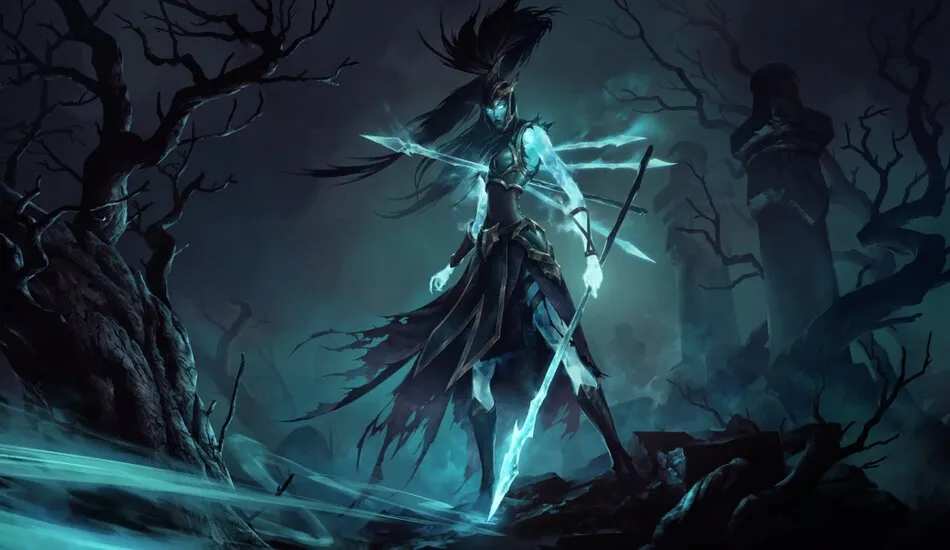Riot Games’ most recent card update in Legends of Runeterra changed one of the worst performing champions in the game, Kalista. While this is not the first time that Kalista has been reworked in LoR, Riot is hoping that these changes keep her League of Legends bonding identity. Additionally, Riot aims to make her feel better to play in more circumstances than before.
The Kalista fundamentals, and answering the questions she asks of you
First let’s take a look at the current iteration of Kalista:

While her health is now stronger at three, her level-up requirement is now also higher with her needing to see four other units to die. The main focus of her rework is her leveled-up form’s ability. When she attacks she will always revive your strongest follower that died this game, then in the same moment she will also bind with that unit and grant it Ephemeral, having her bonded ally take all damage for her.
The strongest follower unit Kalista revives is based on the base stats of a dead unit. So if a massively buffed unit, like a They Who Endure, is destroyed, then it will look at its one power and not consider it if another unit with more base stats died this game.
This effect takes aspects from both previous versions of Kalista and allows her to unleash devastating combos and devastating boards.
With her revival effect being deterministic, you can look at each deck you craft and figure out the hierarchy of which unit will revive each time based on their strength.
Since reaching Kalista’s leveled-up state is more strict now, decks that are seeking to use her leveled-up form need to tailor their decks even more to fuel up Kalista’s need for revenge. While this means staple cards in previous Kalista decks, like Hapless Aristocrat or Cursed Keeper, will safely retain their spots, more token or creature generation are now more vital to helping her flourish.
A deck I’ve used to climb with her

In this midrange deck, you’re aiming to make a board that can withstand hyper-aggressive decks while maintaining a board to sacrifice for Kalista when she eventually arrives. The eventual payoff and strength of her deck is that Avarosan Hearthguard can activate multiple times once Kalista levels up.
When you mulligan with this deck, you want to keep all of your early drops, and you generally only keep Kalista when you have an Elise or many token generators besides her. Wraithcaller is also a fine keep if you have two early plays before turn four, and if you’re against a slower or controlling deck, Hearthguard can be a fine keep as a way to get your value generation rolling early.
When you’re fighting against Jinx, Draven, Ezreal, or Teemo, keeping Black Spear or Vile Feast respectively can destroy the threats of those decks fairly easily and evenly.
While Rhasa and Ledros do not activate their skills when summoned by Kalista or Mist’s Call, they still serve as powerful curve toppers to the deck. Rhasa can destroy an opposing midrange deck’s pace by clearing their board, and Ledros can serve as an inevitability factor against slower controlling decks.
Other fun Kalista ideas to explore
While They Who Endure was shrugged away earlier when talking about who Kalista considers when she revives. That doesn’t mean that you can’t possibly revive They Who Endure. One deck I created as a fun deck building challenge was to make a deck where all followers were one power or less. This guarantees that when They Who Endure have died earlier in the game, they will always win the revival ticket since they win power tiebreakers by having higher costs.

The main weakness of this deck is that early game Fearsome units will run right past you, since the entirety of your deck is only one power or less outside of your champion units. So your spells and combat tricks will need to answer these threats.
Another list to consider Kalista in is to go super aggressive with her and have her serve as another Fearsome unit to try to and rush your opponent down.

While Elise alongside Noxus isn’t a new concept, this deck has Kalista replacing Darius as the one that sits at the top of the champion curve. While Kalista isn’t bound to level up as often as the other decks showcased, her payoff isn’t too bad since she often adds three damage to the board.
Much like other aggressive decks in LoR, your main priority during the mulligan phase is to find an aggressive curve to play out during the first three turns. Elise alongside one drop units are your best keeps that you should always be aiming for. If you have a solid turn one and turn two play, then you can consider keeping Kalista depending on the match up.
One last deck to consider with Kalista is an Ionian shell which uses Death Mark and Zed to dish out the downside of Ephemeral to your opponent while reviving powerful units that your opponent needs to deal with once Death Mark gives them permanence.

When you know you’re facing an aggressive deck, Darkwater Scourge and Death Mark are premier keeps in your mulligan, since the two combined provide a death sentence to aggro decks.
Threats to watch out for with Kalista
Even with the health buff to Kalista, she’s still susceptible to a vast amount of counters. While each region has combat tricks that can destroy an unprepared Kalista, her main fears come from Shadow Isles and Piltover & Zaun.
At three health, Get Excited, Black Spear, Grasp of the Undying, and Thermogenic Beam are all answers that you must take note of. Since each of these cards are conditional or more expensive than Kalista, you need to assess at each moment of the game when you’re willing to give up, or trade with Kalista to maintain tempo or value depending on the overall goals of your deck.
Even after you level up Kalista and attack with her, she’s not 100 percent invincible despite her bonded ally taking all damage for her. In most circumstances, Kalista is generally secure since her bonded ally will always be to the right of her in combat. But if the revived ally is killed with effects, like Single Combat or other removal/damage spells, then Kalista will be open to being killed in combat.
Closing thoughts on the Spear of Vengeance
Kalista’s rework allows her to find more homes than she previously once had. In addition, Kalista all around feels better to play, since if she was summoned to the board excluding from the hand she would lose out on her bonding capability.
While Kalista may not be as effective as other top decks or champions in the meta, this rework cements her identity better to pop up in future metas where wide boards and token spawns can have her lurk in the dangerous mists behind them.







Published: Mar 29, 2020 06:59 pm